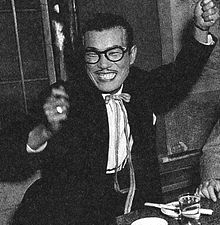Tony Tani
Tony Tani | |
|---|---|
 Tony Tani c. 1950 | |
| Born | 14 October 1917 Chūō-ku, Tokyo, Japan |
| Died | 16 July 1987 (aged 69) |
| Other names | Shotaro Otani (real name) |
| Occupation(s) | Emcee, Comedian, Singer, Actor |
Tony Tani (トニー谷) (14 October 1917 – 16 July 1987) was a popular Japanese entertainer of the 1950s. His flamboyant stage persona satirized American stereotypes of the Japanese as well as the influence of the U.S. occupation on Japanese culture.[1]
Career
[edit]Serving as a popular emcee on radio shows and in dance halls,[2] Tani developed a campy, high-energy stage persona that combined archaic speaking conventions of upper-class madams with caustic catchphrases and anachronistic smatterings of pidgin English.[3] He parodied American style with androgynous eyeglasses, a pencil-thin "Colman" mustache,[4] and slick suits and wig, calling himself "Number One Handsome Boy." Tani channeled Spike Jones with satirical jazz performances, using an abacus as a percussion instrument in lampooning post-war Japan's economic fixations.
Tani openly mocked his audiences, an abrasive style that initially entertained his fans but eventually wore thin on the public and the press, who criticized Tani for lacking humility following the safe release of his kidnapped son in 1955. His popularity waned as Japanese social critics led the nation in reasserting Japan's independent cultural identity, attacking Tani as a symbol of America's "colonization".[1] In later years he worked to revitalize his career amid continued resistance in the press and from the entertainment industry, including producers of nostalgic television retrospectives.[1] He died of liver cancer in 1987.[citation needed]
Cultural legacy
[edit]- Manga creator Fujio Akatsuka based his flashy Osomatsu-kun character Iyami (whose name means gaudy or disagreeable) on Tani.
- The 2011 Pokémon TV series episode "Ohbem, Doubran, and the Dream Thief!" features a character named Leon who is a physical caricature of Tani with behavioral elements of Iyami.
- In 1987 Eiichi Ohtaki produced the album This is Mr. Tony Tani, a compilation of Tani's novelty musical recordings, which combined elements of jazz, mambo, cha-cha-chá, and traditional Japanese music.[5]
References
[edit]- ^ a b c Hasegawa, Kenji (2015). "The Short-Lived Stardom of Tony Tani: America, Parody, and Popular Culture in Post-Occupation Japan". Journal of Tokiwanomori. Retrieved 11 January 2022.
- ^ Seidensticker, Edward (2019). History of Tokyo 1867-1989, From EDO to SHOWA: The Emergence of the World's Greatest City. Tuttle Publishing. ISBN 9781462901050.
- ^ Treat, John Whittier (2018). The Rise and Fall of Modern Japanese Literature. The University of Chicago Press. p. 162. ISBN 978-0226811703.
- ^ Inose, Naoki (2012). Persona; A Biography of Yukio Mishima. Stone Bridge Press. ISBN 9781611725247.
- ^ "Japan in the 50s". Movement.radio. SAE Institute. Retrieved 11 January 2022.
External links
[edit]This article needs additional or more specific categories. (January 2022) |
